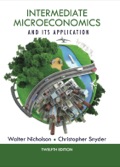
a)
To calculate: The amount of wage rate and associated risk to get the job.
a)
Explanation of Solution
Given
(a).
Let u1 denote the utility of the first job. Since the first job gives a constant work hour of 8 hours at an hourly wage of $50, the utility would be:
Let u2 denote the utility of the risky job. Sometimes the salesman gets 4 hours of work with probability 0.5 and sometimes he gets 12 hours of work with probability 0.5, then the expected utility from the risky job is:
The risky job will be chosen ifu1 > u2
Hence, for an hourly wage rate higher than 53.6, the risky job will be taken.
b)
To show: Whether the imposition of proportional tax on income will impacts decisions regarding choice of job.
b)
Explanation of Solution
If the proportional tax is imposed on both the risky job and a certain job, then results do not change as the expected utility difference remains the same. Let us check:
Let the proportional tax rate be, t. Utility in case of a certain job will be:
Utility in case of the risky job will be:
The risky job will be chosen if u1 > u2
The wage rate for both jobs remains the same so, the person’s choice will not be impacted.
c)
To calculate: Let us calculate the utility to decide whether the decision will be impacted or not:
c)
Explanation of Solution
Utility in case of constant working hours:
In this case, 300 will not be taxed and 100 (400-300) will be taxed at the rate of 50%
Utility in case of random working hours:
In this case, also 300 will not be taxed and wages above 300 will be taxed at the rate of 50%
Since, in this case, the equation of wages has changed the decision will also change.
Want to see more full solutions like this?
Chapter 13 Solutions
EBK INTERMEDIATE MICROECONOMICS AND ITS
- As indicated in the attached image, U.S. earnings for high- and low-skill workers as measured by educational attainment began diverging in the 1980s. The remaining questions in this problem set use the model for the labor market developed in class to walk through potential explanations for this trend. 1. Assume that there are just two types of workers, low- and high-skill. As a result, there are two labor markets: supply and demand for low-skill workers and supply and demand for high-skill workers. Using two carefully drawn labor-market figures, show that an increase in the demand for high skill workers can explain an increase in the relative wage of high-skill workers. 2. Using the same assumptions as in the previous question, use two carefully drawn labor-market figures to show that an increase in the supply of low-skill workers can explain an increase in the relative wage of high-skill workers.arrow_forwardPublished in 1980, the book Free to Choose discusses how economists Milton Friedman and Rose Friedman proposed a one-sided view of the benefits of a voucher system. However, there are other economists who disagree about the potential effects of a voucher system.arrow_forwardThe following diagram illustrates the demand and marginal revenue curves facing a monopoly in an industry with no economies or diseconomies of scale. In the short and long run, MC = ATC. a. Calculate the values of profit, consumer surplus, and deadweight loss, and illustrate these on the graph. b. Repeat the calculations in part a, but now assume the monopoly is able to practice perfect price discrimination.arrow_forward
- how commond economies relate to principle Of Economics ?arrow_forwardCritically analyse the five (5) characteristics of Ubuntu and provide examples of how they apply to the National Health Insurance (NHI) in South Africa.arrow_forwardCritically analyse the five (5) characteristics of Ubuntu and provide examples of how they apply to the National Health Insurance (NHI) in South Africa.arrow_forward
 Economics (MindTap Course List)EconomicsISBN:9781337617383Author:Roger A. ArnoldPublisher:Cengage Learning
Economics (MindTap Course List)EconomicsISBN:9781337617383Author:Roger A. ArnoldPublisher:Cengage Learning

 Managerial Economics: A Problem Solving ApproachEconomicsISBN:9781337106665Author:Luke M. Froeb, Brian T. McCann, Michael R. Ward, Mike ShorPublisher:Cengage Learning
Managerial Economics: A Problem Solving ApproachEconomicsISBN:9781337106665Author:Luke M. Froeb, Brian T. McCann, Michael R. Ward, Mike ShorPublisher:Cengage Learning






